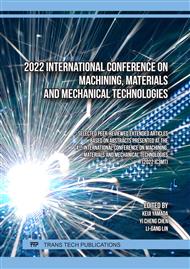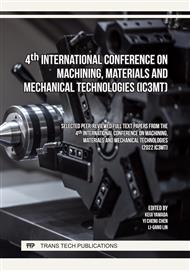[1]
Qin S, McTeer A. Deep-depletion breakdown of Johnsen-Rahbek type electrostatic chuck operation for semiconductor processes. J Appl Phys. (2008) 104.
DOI: 10.1063/1.3006441
Google Scholar
[2]
Van Elp J, Giesen PTM, De Groof AMM. Low-thermal expansion electrostatic chuck materials and clamp mechanisms in vacuum and air. Microelectron Eng. 73–74 (2004) 941–7.
DOI: 10.1016/s0167-9317(04)00248-5
Google Scholar
[3]
Jang KH, Lee HJ, Lee SH. Evaluation of surface temperature uniformity of multi-zone ceramic heaters with embedded cooling channels for electrostatic chuck. Journal of Mechanical Science and Technology. 36 (2022) 1599–606.
DOI: 10.1007/s12206-022-0245-0
Google Scholar
[4]
Suzuki A, Shinka Y, Masuko M. Tribological characteristics of imidazolium-based room temperature ionic liquids under high vacuum. Tribol Lett. 27 (2007) 307–13.
DOI: 10.1007/s11249-007-9235-8
Google Scholar
[5]
Zhang S, Hu L, Qiao D, Feng D, Wang H. Vacuum tribological performance of phosphonium-based ionic liquids as lubricants and lubricant additives of multialkylated cyclopentanes. Tribol Int. 66 (2013) 289–95.
DOI: 10.1016/j.triboint.2013.06.012
Google Scholar
[6]
Kawada S, Sasaki S, Miyatake M. In-situ observation of tribo-decomposition behavior of ionic liquids composed of phosphonium-cation and cyano-anion using quadrupole mass spectrometer. Tribol Int. (2021) 153.
DOI: 10.1016/j.triboint.2020.106547
Google Scholar
[7]
Goindi GS, Jayal AD, Sarkar P. Application of ionic liquids in interrupted minimum quantity lubrication machining of plain medium carbon steel: Effects of ionic liquid properties and cutting conditions. J Manuf Process 32 (2018) 357–71.
DOI: 10.1016/j.jmapro.2018.03.007
Google Scholar
[8]
Minea AA. Overview of Ionic Liquids as Candidates for New Heat Transfer Fluids. Int J Thermophys (2020) 41.
DOI: 10.1007/s10765-020-02727-3
Google Scholar
[9]
Okabe T, Utsumi K, Somaya K, Miyatake M, Yoshimoto S, Taniguchi J, et al. Development of a vacuum-compatible hydrodynamic spindle using an ionic liquid as a lubricant. Precis Eng. 40 (2015) 124–30.
DOI: 10.1016/j.precisioneng.2014.10.013
Google Scholar
[10]
Okabe T, Utsumi K, Ogino K, Shinonaga Y, Miyatake M, Yoshimoto S, et al. Electron beam mastering system using a vacuum-compatible hydrodynamic spindle. Microelectron Eng. 142 (2015) 64–9.
DOI: 10.1016/j.mee.2015.07.014
Google Scholar
[11]
Okabe T, Sasaki S, Kondo Y, Miyatake M, Yoshimoto S. Hydrostatic ionic liquid-lubricated fluid film bearing for a rotational electron-beam lithography system. Precis Eng. 61 (2020) 194–203.
DOI: 10.1016/j.precisioneng.2019.10.008
Google Scholar



